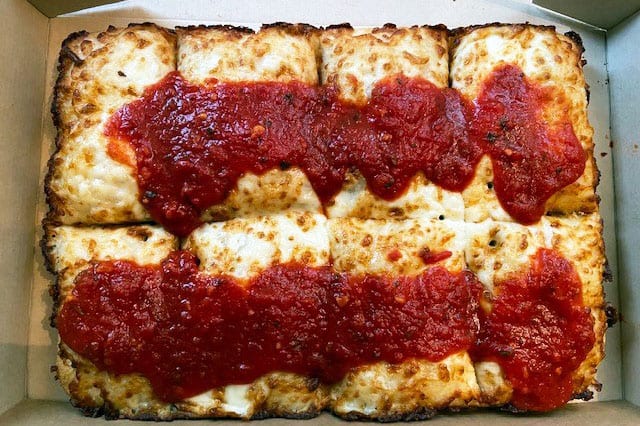Pizza Hut’s Detroit style is crunchy and cheesy, but one expert says Motor City natives ‘would be offended’

After years of enjoying the thin-crusted New York or Neapolitan-style slices that had been the standard for most quality pizza purveyors I had encountered, I found the Detroit pizza’s pillowy crust, with a crunchy, nearly deep-fried exterior, satisfying. But it wasn’t entirely unfamiliar.
Digging into a slab from a local pie shop recently brought me back to a childhood memory. I was suddenly 8 years old and staring in awe of a feast before me: a personal pan pizza from Pizza Hut, in a piping hot skillet, for me alone to devour — the pepperoni-topped bounty from my school’s Book It reading program.
So when I saw the announcement Tuesday that the pizza giant was debuting its very own Detroit-style pizza, I was optimistic that the offering would bridge my nostalgic reminiscence with a favorite new-to-me trend.
Pizza Hut’s version sounded enticing — and thoroughly researched. The company boasts in a news release that it spent a year developing the pizza, during which it tried 500 iterations (presumably discarding 499). Each of its double-pepperoni pizzas features 32 slices of regular pepperoni and an additional 48 that crisp into the cup shaped discs familiar to Detroit pizza aficionados.
And so I ordered two versions of the new menu item — the aforementioned double pepperoni and the double cheese. (It also comes in an even more meat-laden variety that adds bacon and sausage to the mix and another, the “supremo,” topped with Italian sausage, red onions and green bell peppers). Because I thought I should enlist someone for whom the Detroit-style is a native language, I also ordered the same pies for Chris Powers, a co-founder of Ivy and Coney, a bar in D.C.’s Shaw neighborhood themed in homage to its owners’ hometowns of Detroit and Chicago.
Powers grew up just north of the Motor City and added Detroit-style pizza to Ivy and Coney’s takeout menu after the pandemic made more delivery-friendly food a necessity, so he knows what goes into a good slice … er, slab. We each sampled our respective deliveries, and then I chatted with Powers for a debrief.
To start with, I was more impressed than he was. My pies had some of the crisp/soft juxtaposition that I had hoped for: I appreciated the lacy ring of sizzled cheese that surrounded them, following the instructions on the box to nab a corner piece for two sides of crunch. The crust was pleasantly springy, even if the bottom wasn’t as crisp as I’d hoped. The curly-edged pepperoni, too, offered another layer of texture and a salty counterpoint to the slightly too-sweet sauce (though I didn’t count them to make sure they matched Pizza Hut’s promised figures).
But Powers was even more discerning. He did approve, at least, of the classic construction. The Hut’s lab wizards layered cheese directly over the dough, then topped it in two “stripes,” often a hallmark of the style, he notes, which are sauced only after a turn in the oven. That’s a technique used by Buddy’s, the beloved chain of his youth whose recent expansion has helped fuel the craze for Detroit’s pies, and can keep the dough from being weighed down while it bakes.
But appearances can be deceiving, and Powers pointed to a literary reference to describe the disconnect. In the sci-fi classic “The Hitchhiker’s Guide to the Galaxy,” a machine called the “Nutri-Matic” attempts to create the user’s desired beverage. The result for a British Earthling? “A liquid that was almost, but not quite, entirely unlike tea.”
Pizza Hut’s latest concoction similarly “looks like a Detroit pizza — all the cornerstone elements are represented,” Powers says. “But they’re all a little off, so when you put them all together it ends up entirely different.”
His quibbles: The crust wasn’t nearly crisp enough; the cheese on his pizzas didn’t extend to the edges, as promised, and besides which, it wasn’t the classic Wisconsin brick, whose low moisture gives it the feeling of cheese curds, he says, and the sauce’s sweetness marred the whole.
And so perhaps this is a pie to be enjoyed by people who don’t know better yet. Which clearly doesn’t include our friends up north. Powers’ final verdict? “Anyone who grew up in Detroit would probably be offended.”






